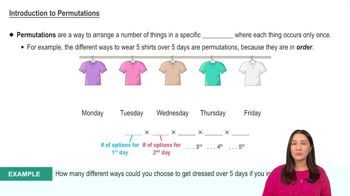Here are the essential concepts you must grasp in order to answer the question correctly.
Permutations
Permutations refer to the different arrangements of a set of items where the order matters. In this context, the five airplanes can be arranged in various sequences for departure, and each unique sequence is considered a different permutation. The formula for calculating permutations of 'n' items is n!, which represents the product of all positive integers up to 'n'.
Recommended video:
Introduction to Permutations
Factorial
The factorial of a non-negative integer 'n', denoted as n!, is the product of all positive integers from 1 to n. Factorials are essential in combinatorial problems, such as determining the number of ways to arrange items. For example, 5! equals 5 × 4 × 3 × 2 × 1, which equals 120, representing the total arrangements of five airplanes.
Recommended video:
Combinatorial Counting
Combinatorial counting involves techniques used to count the number of ways to arrange or select items from a set. In this scenario, we are interested in counting the arrangements of airplanes, which falls under permutations. Understanding combinatorial principles helps in solving problems related to arrangements, selections, and distributions in various mathematical contexts.
Recommended video:
Fundamental Counting Principle
 Verified step by step guidance
Verified step by step guidance Verified video answer for a similar problem:
Verified video answer for a similar problem:



 4:4m
4:4m